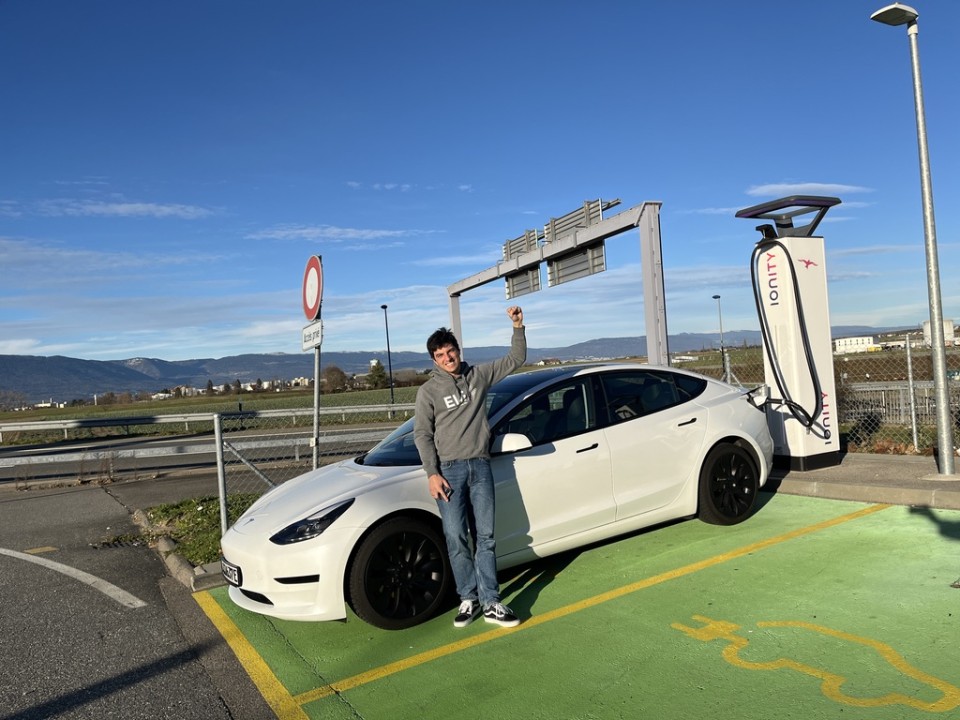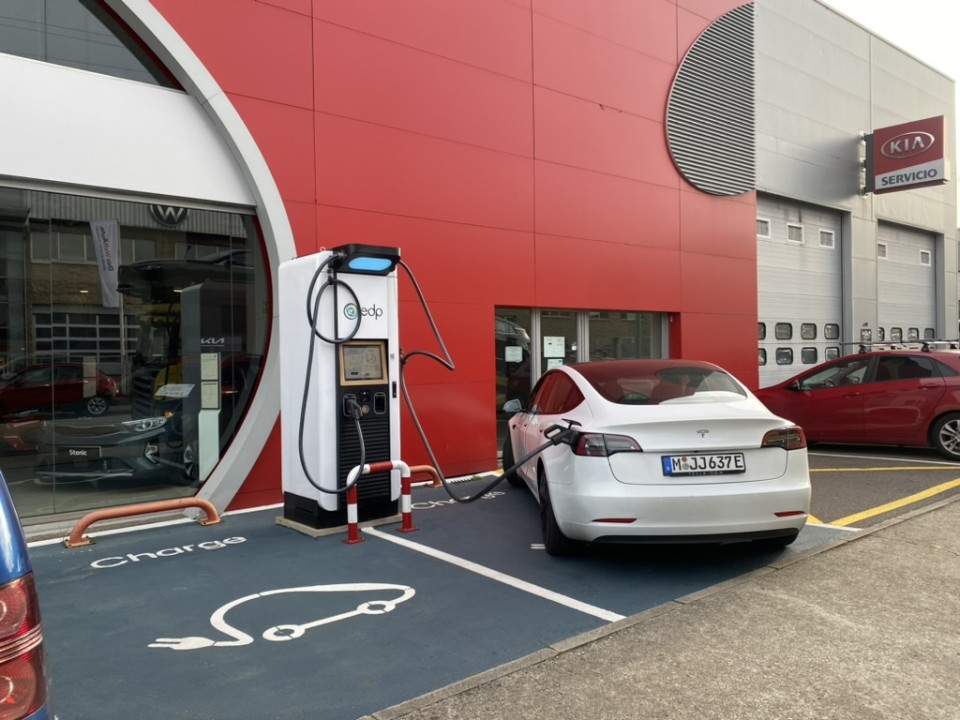From Ingolstadt to Spain: an electric road trip with the Elli app
Shortly after Christmas, Jose de Lorenzo Tabales, Technical Operations Manager at Elli, got behind the wheel and drove 2,500 km from Germany to Spain. He planned the trip with the Elli Charging app. A field report.
I asked myself: Is it possible to drive 2,500 km from Germany to Spain without the Tesla Supercharging network? Time for a test! We started in Ingolstadt: My wife and I got into our Tesla Model 3 Standard (60kWh LFP battery pack from 2022) on the morning of December 25 and set off. The day before, I had plugged the car into the AC charging station at a parking lot in Ingolstadt. Since Elli doesn't have any overnight charging fees, this gives me a competitive advantage over other MSPs. On the 25th, I was able to start with 100% charging at a price of €18.45 for 34.2 kWh over a period of 14 hours.

Total distance and time from Ingolstadt to Clermont-Ferrand
If you have a 2,500 km journey ahead of you, you first have to think about where you want to spend the night. We didn't want to make the journey without stops, so we planned the route accordingly. We wanted to spend the first night in a hotel in France and then head towards Bilbao. On the third day, we had planned to arrive in my home town of O Rosal in Galicia - before that, we had planned a stop in Viveiro in the north of Galicia.
On the first day, we chose Clermont-Ferrand as a stopover to split the journey to Bilbao into two sections. The first 1,000 km and the second 730 km. The third section was about 800 km across northern Spain to get to my home town. For precise planning, I searched for the fastest route using Google Maps and found that the route via Switzerland was shorter and took almost the same amount of time.

Planning with the Elli app
I downloaded the Elli Charging app and used the beta function "Plan route".
I used Elli's Selected Partner Network to select the stops where I would pay €0.50/kWh.
I saved the best places for the trip in favorites (I had to add this extra because I drive a Tesla which has no route planning other than Supercharger to Supercharger). This worked well for the first three sections of the trip. In Spain it gets a bit more complicated. More on that later.

Ideally, anyone who uses Elli's service should have &charge as a combo. Why? Because you can take part in challenges at the charging stations and get up to 120 km of credits. For hotel bookings, for example, you get 100 km per €200 booking.
These kilometers can be exchanged for Elli vouchers, with 250 km being charged at €20. I have summarized the total numbers again at the end (after returning home, I exchanged another 600 km for vouchers.
We stopped first at the Ionity station at the Lechwisen Nord service area - after 133 km and 1:09 hours of driving. The consumption was 24.7 kWh / 100 km due to the high speed (150-160 km/h), the condition of the battery and the headwind, which cost me a total of 60 percent of the battery.

Using RFID to start the charging process at Ionity
We stopped for exactly 20 minutes, charged 30.5 kWh and paid €15.23. I did a few &Charge Challenges there to collect some kilometers. The next stop was already in Switzerland, after we had driven 235 km in 2:08 hours with a consumption of 17.4 kwh / 100 km. We stopped for 30 minutes and charged 44 kWh for 22.19 CHF. At this stop I managed 120 km with &charge. We did this at every stop. The consumption was lower because the battery was already warm. When you're driving in winter in cold temperatures, you need more juice on the first section. This gets even worse if the battery has LFP chemistry. The good thing about Ionity on this route is that all stations are located directly on the highway, which avoids detours and saves time. The price was slightly more expensive compared to Tesla's Superchargers.
At 86%, I shared the next station in Switzerland with the car and arrived at 37% after 2 hours and a 200 km drive. For a bit more I could have skipped this station and got to the next one, but 120 km more was too much. We stopped here for 22 minutes and 31.4 kWh for 15.68 CHF. After a short break and a driver swap, we continued on.
The last stop was planned after 248 km and 2:20 hours of driving (14.7 kWh / 100 km), where we arrived with 23% battery. We charged in France for 22 minutes, 33.8 kWh and €16.92. I have to admit that Ionity and other HPC have very good locations, whereas Tesla offers better prices (€0.30 / kWh) but worse locations and you have to take up to 10 minutes detour.
We overcame the last &charge challenges and drove the remaining 176 km to the hotel in France, where we were able to charge overnight at AC again - with blocking fees and at a very good price of €0.35/kWh.

Personal record on the highway route
In total we drove 11 hours and 1,000 km, which is very close to the results of Bjorn Nyland and his 1,000 km challenge, where he did it in 10:20 hours. Google Maps also showed 10:XX hours, so we weren't very far off the actual ride time. I definitely got my best record on highway routes, mainly thanks to the Ionity network, which is very close to the highways and saves up to 10 minutes per charging stop. if you take into account deviations like the trip to the Tesla Superchargers. Note - this doesn't happen everywhere, I'd say France is special.
The next morning, with the car at 100%, we headed towards Bilbao. The plan was to make it with two Ionity stops. But we noticed that there were a lot of charging stations everywhere. France is massively installing HPC along the highways, mainly because of the strict regulations that force gas stations to have HPC installed and online (yes, online too - if I'm not mistaken, Gireve checks the quality and functionality so the CPO gets the subsidies).
We drove the 740 km with two stops. The first was for breakfast after 300 km, it took 43 minutes to charge 55.7 kWh for €27.86. It was interesting that we drove slower than the permitted highway speed (125kmh instead of 135kmh) and that at temperatures below 0°C the whole time. We arrived at Ionity with 4% and a pre-warmed battery for 174 kw peak charge. In the first 20 minutes we charged up to 68%, in the next 23 minutes we charged up to 96%.

Pit stop before the Spanish border
The second pit stop then took place 50 km before the Spanish border for 18 minutes. Again easy and close to the highway. I shared all the stops with the car after saving them in my favorites. The tricky part was that the car had to preheat the battery. Sometimes it worked on Ionity and sometimes I had to add an additional destination to a Tesla Supercharger. In winter, it's important to get the battery hot enough to maintain full peak power when the state of charge is low. If you want to eat lunch while charging, you don't have to preheat.
We then easily made it to Bilbao where we parked the car at a hotel I'd booked where you could charge with AC. I didn't realize it was Endesa until I got there, so I used the Elli app again to start the AC charging overnight for €0.39/kWh (a bit overpriced, but cheap compared to Germany). We enjoyed the evening in Bilbao and drove the next day with 100% battery charge towards Viveiro, where I had reserved a table for 2pm.
Bilbao-Viveiro is a 450 km route that requires a stopover. In my opinion, there is a lack of HPC stations in the north of Spain - especially compared to France. I chose a station near Gijón from the operator EDP with a total capacity of 210 kW. I expected peak power, but when we got there the battery was cold and I couldn't charge very quickly, so we took advantage of the 30-minute stop to have a coffee at a gas station. The location wasn't ideal, but there was nothing better nearby, just a few other 50 kW or 100 kW CPOs within a 50 km radius.
EDP is not part of the Selected Partner Network program, so I had to pay €0.59 per kWh. 43.5 kWh later, we drove to Viveiro, where we plugged the car into an AC charger at Wenea for €0.39/kWh while we had lunch on the beach. A little anecdote: the only thing that didn't work during the trip was booking a restaurant. I was told it was closed, but we had lunch on the beach anyway.

Wenea: Cool system with solar panels in Viveiro
Two and a half hours later, we drove to the south of Galicia and stopped in Lugo for our first Flexpole charge. Iberdrola doesn't participate in Elli's Selected Partner Network program either, so I had to pay €0.59/kWh. We only charged for 12 minutes to check out the charging station, which wasn't in the best location either. A car dealership is not the best place for an HPC stop, but it was fine.

Flexpole in Lugo
After picking up my mother in Ourense, I realized that I wasn't going to make it home, so I had to make an extra stop on the way to Iberdrola. The stop was done quickly - the only problem here was that RFID wasn't working, but the remote start via app worked.

Costs
Once home, I did a cost breakdown: 2,500 km, 430 kWh consumed – 460 kWh for a total of €220. I received discounts of €76 from &Charge, so I ended up paying €144 plus the monthly Elli tariff subscription fee. Since I still collected a few kilometers from &Charge, these were converted into vouchers for the return trip, which brought further discounts.
Conclusion: The industry is maturing very quickly. Operators are continuously improving the service. Spain needs more HPC, especially in the north. Nevertheless, I managed it without any problems. Also otherwise: no billing errors, no problems with authorization, no cold gate, no waiting times. With the Tesla Supercharger Network I would have been neither cheaper nor faster.
